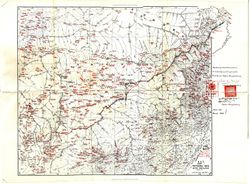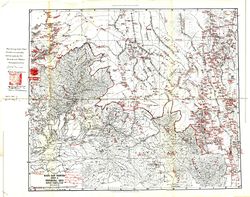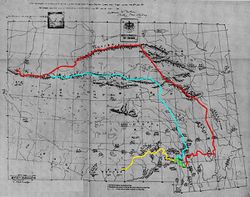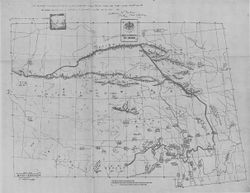اتفاقية سملا (1914)
| معاهدة بين بريطانيا العظمى والصين والتبت | |
|---|---|
 المشاركون والمفوضون التبت والبريطانيون والصينيون في معاهدة سملا في 1914 | |
| المسودة | 27 أبريل 1914 |
| وُقـِّعت | 3 يوليو 1914 |
| المكان | سملا، Punjab Province, الراج البريطاني |
| Expiry | 23 May 1951 29 أكتوبر 2008 (حسب المملكة المتحدة) |
| المفاوضون | |
| الموقعون | |
| المصدقون | |
| اللغات | |
اتفاقية سملا Simla Accord، (بالصينية التقليدية: 西姆拉條約؛ بالصينية المبسطة: 西姆拉条约) وتُدعى رسمياً المعاهدة بين بريطانيا العظمى والصين والتبت، [في] سِملا،[1] كانت معاهدة غامضة[2] تتعلق بوضع التبت تفاوض عليها ممثلو جمهورية الصين والتبت والمملكة المتحدة في سملا في 1913 و 1914.
The Accord provided that Tibet would be divided into "Outer Tibet" and "Inner Tibet". Outer Tibet, which roughly corresponded to Ü-Tsang and western Kham, would "remain in the hands of the Tibetan Government at Lhasa under Chinese suzerainty", but China would not interfere in its administration. "Inner Tibet", roughly, equivalent to Amdo and eastern Kham, would be under the jurisdiction of the Chinese government. The Accord with its annexes also defines the boundary between Tibet and China proper and between Tibet and British India (the latter became known as the McMahon Line).[1][3][أ]
China rejected the Accord and their plenipotentiary, Ivan Chen, withdrew on 3 July 1914. The British and Tibetan plenipotentiaries then attached a note denying China any privileges under the Accord and sealed it as a bilateral agreement the same day.[4][ب][5] The British records show that there are conditions for the Tibetan government to accept the new border in 1914, the condition was that China must accept the Simla Convention, since the British was not able to get an acceptance from China, Tibetans considered the McMahon Line invalid.[6]
McMahon's work was initially rejected by the British government as incompatible with the 1907 Anglo-Russian Convention. This convention was renounced in 1921. The British began using the McMahon Line on Survey of India maps in 1937, and the Simla Accord was published officially in 1938.[ت]
خلفية
Early British efforts to create a boundary for north-east India were triggered by their discovery in the mid-19th century that Tawang, an important trading town, was Tibetan territory.[7] Britain had concluded treaties with Qing China concerning Tibet's boundaries with Burma[8] and Sikkim.[9] However, Tibet refused to recognise the boundaries drawn by these treaties[بحاجة لمصدر]. British forces led by Sir Francis Younghusband entered Tibet in 1904 and made a treaty with the Tibetans.[10] In 1907, Britain and Russia acknowledged Chinese "suzerainty" over Tibet.[11]
خرائط
انظر أيضاً
ملاحظات
- ^ The map was finalised on 24/25 March 1914 by the British and Tibetan plenipotentiaries. Indian sources currently claim that, on being informed of the line, the Chinese plenipotentiary did not express any disagreement.(Sinha, (Calcutta 1974), p. 12 (pdf p. 8))
The two maps (27 April 1914 and 3 July 1914) illustrating the boundaries bear the full signature of the Tibetan Plenipotentiary; the first bears the full signature of the Chinese Plenipotentiary also; the second bears the full signatures along with seals of both Tibetan and British Plenipotentiaries. (V. Photographic reproductions of the two maps in Atlas of the North Frontier of India, New Delhi: Ministry of External Affairs 1960)
— Sinha (21 February 1966), p. 37(Goldstein, M.C., A History of Modern Tibet, 1913–1951: The Demise of the Lamaist State, 1989, p. 80. Quotes India Office records IOR/L/PS/10/344).
The Indian Government opened bilateral negotiations with the Tibetans in Deli in February–March 1914 (the conferees having retreated from the Simla winter) with the object of securing Tibetan agreement to the proposed alignment.
— Gupta, Karunakar, The McMahon Line 1911–45: The British Legacy - ^ This Accord was initialled and sealed by the British plenipotentiary, A. Henry McMahon, and sealed by the Tibetan plenipotentiary Lochen Shatra but not the Chinese plenipotentiary, Ivan Chen, as he had withdrawn from the Convention before the Accord was initialled and sealed.("Convention Between Great Britain, China, and Tibet, Simla (1914)", Tibet Justice Center Archived 10 مارس 2009 at the Wayback Machine. Retrieved 20 March 2009).
- ^
The Simla Convention and its appended Indo-Tibetan agreement did not appear in Aitchison's Treaties (the official GOI record), including the final 1929 edition, since the unratified Simla Convention was not a valid international treaty and the Indo-Tibetan agreement was secret. The 1929 edition was withdrawn by a British Indian official, Olaf Caroe, in 1938, and a new edition was issued that included the Simla Convention and the McMahon-Shartra notes (but not the Anglo-Tibetan agreement or the McMahon Line map)
— Smith, Warren, Tibetan Nation, p201, n163
المراجع
الهامش
- ^ أ ب "Convention Between Great Britain, China, and Tibet, Simla (1914)", مركز عدالة التبت. Retrieved 20 March 2009
- ^ Hoffmann 1990, p. 19: "McMahon's achievement seemed substantial at the time, but its meaning proved to be ambiguous at best."
- ^ Sinha (Calcutta 1974), p. 12 (pdf p. 8)
- ^ Goldstein 1991, p. 837.
- ^ Sinha (Calcutta 1974), pp. 5,12 (pdf pp. 1,8)
- ^ Tsering Shakya (1999). The Dragon in the Land of Snows: A History of Modern Tibet Since 1947. Columbia University Press. pp. 279–. ISBN 978-0-231-11814-9.
- ^ Calvin, James Barnard, "The China-India Border War", Marine Corps Command and Staff College, April 1984
- ^ Convention Relating to Burmah and Tibet (1886), Tibet Justice Center Archived 10 مارس 2009 at the Wayback Machine. Retrieved 20 March 2009
- ^ "Convention Between Great Britain and China Relating to Sikkim and Tibet (1890)", Tibet Justice Center Archived 10 مارس 2009 at the Wayback Machine. Retrieved 20 March 2009
- ^ "Convention Between Great Britain and Tibet (1904)", Tibet Justice Center Archived 10 مارس 2009 at the Wayback Machine. Retrieved 20 March 2009
- ^ Convention Between Great Britain and Russia (1907) Article II, Tibet Justice Center Archived 10 مارس 2009 at the Wayback Machine. Retrieved 20 March 2009
المصادر
- Aitchison, C.U. "Convention Between Great Britain, China, and Tibet, Simla", A Collection of Treaties, Engagements And Sanads, Vol XIV, Calcutta 1929, pp. 21 & 38. (Official British colonial treaty record), on the website of the Tibet Justice Center. Retrieved 2009-03-20
- Barnard, James (Lieutenant Commander,U. S. Navy). The China – India Border War (1962), Marine Corps Command and Staff College, April 1984, republished as The China-India Border War, globalsecurity.org. Retrieved 2009-04-11.
- Lunn, Jon. Tibet (SN/IA/5018), International Affairs and Defence Section, British Parliamentary Briefing Paper, 20 March 2009.
- Maxwell, Neville. India's China War (1970) Jonathan Cape. ISBN 0-224-61887-3.
- Goldstein, Melvyn C. (1991), A history of modern Tibet, 1913–1951: the demise of the Lamaist state, University of California Press, pp. 75, 307, 837, ISBN 978-0-520-07590-0
- Goldstein, Melvyn C. (1997), The Snow Lion and the Dragon: China, Tibet, and the Dalai Lama, University of California Press., pp. 30–31, ISBN 978-0-520-21951-9
- Namoyal, Gyalmo Hope; Gyaltshen T. Sherab; Sinha, Nirmal C. (editors). Bulletin of Tibetology, Gangtok Sikkim, Vol III No, 1. 21 February 1966, Director Namgyal Institute of Tibetology, Gantok.
- Sinha, Nirmal C. Article "Was the Simla Convention not signed?" pp. 33–38
- Shakya, Tsering. The Dragon in the Land of Snows (1999) Columbia University Press. ISBN 0-231-11814-7
- Sinha, Nirmal C. The Simla Convention 1914: A Chinese Puzzle, Reproduced from the Presidency College Magazine: Diamond Jubilee Number (Calcutta 1974).
- Staff, "Convention Between Great Britain, China, and Tibet, Simla (1914)", Tibet Justice Center. Retrieved 2009-03-20
وصلات خارجية
 Works related to اتفاقية سملا (1914) at Wikisource
Works related to اتفاقية سملا (1914) at Wikisource
- Short description is different from Wikidata
- Articles with unsourced statements from July 2007
- 1913 في الصين
- 1913 في الهند
- 1913 في العلاقات الدولية
- 1913 في الامبراطورية البريطانية
- 1913 في التبت
- 1914 في الصين
- 1914 في الهند
- 1914 في العلاقات الدولية
- 1914 في الامبراطورية البريطانية
- 1914 في التبت
- معاهدات حدودية
- الامبراطورية البريطانية
- حدود الصين-الهند
- العلاقات التبتية الصينية
- العلاقات البريطانية الصينية
- جغرافيا التبت
- تاريخ العلاقات الخارجية للهند
- تاريخ التبت
- Shimla
- العلاقات البريطانية التبتية
- Treaties concluded in 1914
- Treaties extended to British India
- Treaties of Sikkim
- معاهدات جمهورية الصين (1912–49)
- معاهدات المملكة المتحدة (1801–1922)
- معاهدات التبت
- معاهدات غير متكافئة



